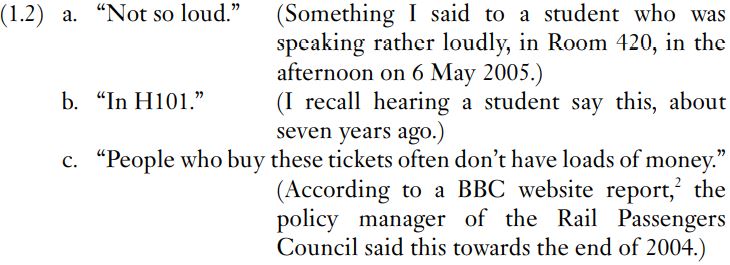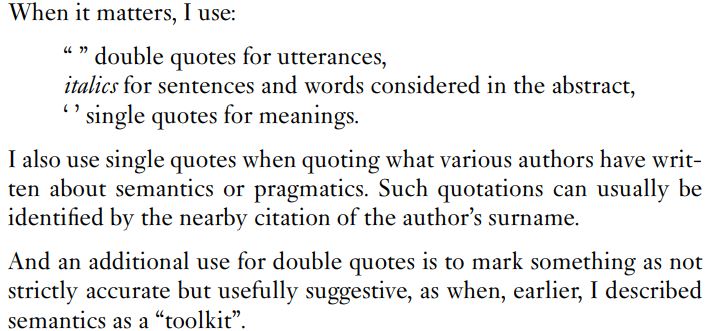
Utterances and sentences
 المؤلف:
Patrick Griffiths
المؤلف:
Patrick Griffiths
 المصدر:
An Introduction to English Semantics And Pragmatics
المصدر:
An Introduction to English Semantics And Pragmatics
 الجزء والصفحة:
4-1
الجزء والصفحة:
4-1
 9-2-2022
9-2-2022
 1069
1069
Pragmatics distinguished from semantics
Utterances and sentences
In our immediate experience as language users, the things that have meaning are utterances, and (1.2) presents three examples.

Utterances are the raw data of linguistics. Each utterance is unique, having been produced by a particular sender in a specific situation.
(Though it may seem a bit strange, I will use the term utterance to cover not only spoken utterances but also individual stretches of written language up to sentence-size, done by a particular person at a particular time.) Because they are tied to a sender and a time, utterances can never be repeated. When early in the morning on 6 May 2005 I said, in our apartment, “Not so loud”, because I was worried that the noise of our TV might bother the neighbors, that was a different utterance from (1.2a). Even when someone is held to have said (or written) “the same thing twice”, as in the case of people who “repeat themselves” (or someone who repeats what someone else has uttered), there is going to be more than one utterance constituting the repetition – differing in time, or having been made by a different speaker. No-one keeps a record of every utterance, but in principle they are all distinguishable

The abstract linguistic object on which an utterance is based is a sentence. My recollection is that the utterance “In H101” mentioned in (1.2b) was based on the sentence The class will be in Room H101, because it was said in response to me asking “Where’s the class going to be?” We talk of repetition when two or more utterances are based on the same sentence.
Utterances are interpreted in context. The context of (1.2c) indicated clearly that often was to be understood as modifying what followed it, to mean ‘… are often not rich’, rather being a modifier of what came before: ‘People who buy these tickets often …’. I read about (1.2c) in a report on the internet. If I had heard the utterance, it is likely that the speaker’s delivery would have signaled which of the two meanings was intended. For the ‘frequent purchaser’ meaning, there would probably have been an intonational break straight after often, one that the report writer could have marked with a comma. Without such a break, either interpretation would be possible, but the absence of a break could be taken as a pointer towards the ‘often not well off ’ interpretation. Nonetheless, intonation does not obviate the need to consider context: we tend to use context to check that we have heard the intonation correctly, and to treat intonation as a clue regarding which contextual information to use.
 الاكثر قراءة في pragmatics
الاكثر قراءة في pragmatics
 اخر الاخبار
اخر الاخبار
اخبار العتبة العباسية المقدسة


